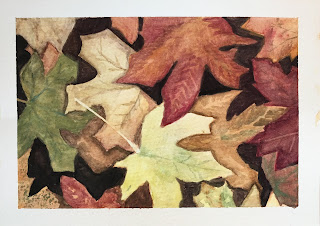To familiarize themselves with the process, my students watched a few negative space painting videos on YouTube before coming to class. There are many good tutorials out there, but here a few that we watched.
Video 1
Video 2
Video 3
Students decided on a leaf variety to paint. Important was that their leaf shape is rather simple, since they'd be painting around this shape again and again in order to build up many layers of depth.
Students had many visuals of leaves to choose from.
Step 1: A light wash of color was painted across our entire paper. This first layer of color will eventually be the color of the leaves in our foreground, so those that are most in the front of our composition. A bit of variation in this first color adds interest, and will look more realistic, since leaves are rarely a solid, flat color, but are composed of many colors and imperfections. So splashing or dabbing a bit a different color here and there is all good, as long as this is also a very light color.
Step 2: Students sketch our a simple leaf composition with 5-7 leaves. For good composition, leaves should be facing in different directions, and should vary in size. These are the leaves that will be in the front of our composition.
Step 3: Begin painting. Students mix a color that is a bit darker than their first wash of color, and they proceed to paint AROUND their drawn leaves.
Step 4: Students draw several more leaves, again thinking of good composition. Some leaves should underlap those in the front.
Step 5: Students mix a color darker than their second color, and paint AROUND all the leaves.
Step 6: More leaves are drawn. Some underlap those in front.
Step 7: A darker color is mixed and again the leaves are painted around.
Continue these steps until the composition is full of leaves, there is lots of overlapping, and there is lots of depth.
Finishing touches
Students add a little more detail to their leaves, to make them more realistic, to add a bit of texture, or to enhance the shadow and highlights. This could include adding faint veins, imperfections, shadows were there may be a bend or indent in the leaf, etc. Very important for creating a sense of depth is adding a slight shadow along the edge of any leaf where it overlaps another.
One watercolor techniques we used for adding faint veins on our leaves was 'lifting', in which the color is lifted by lightly scrubbing the vein lines away with a wet brush.
My adults found his technique challenging but fascinating. It's one that requires a lot of practice, but for a first time exploration, I'd say we all did pretty well, and students went home happy with their results.




